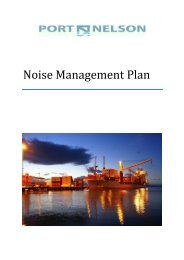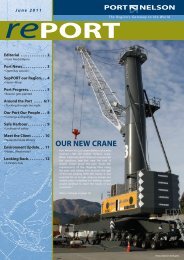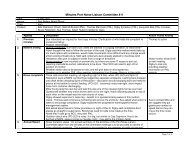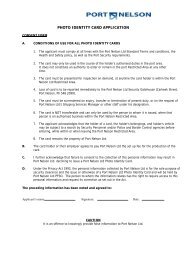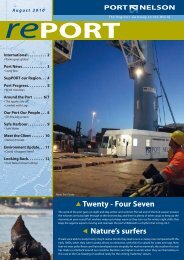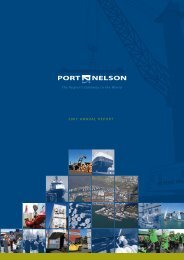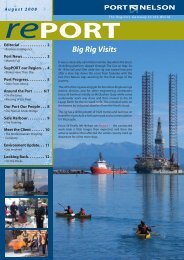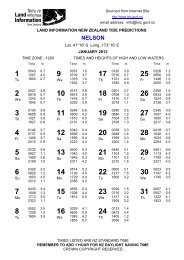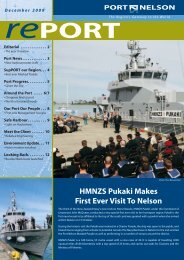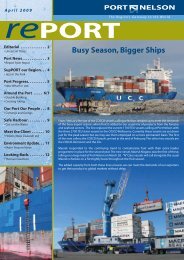Port Nelson Annual Report 2012 (pdf)
Port Nelson Annual Report 2012 (pdf)
Port Nelson Annual Report 2012 (pdf)
Create successful ePaper yourself
Turn your PDF publications into a flip-book with our unique Google optimized e-Paper software.
summary of significant accounting policies<br />
policies<br />
1.7 Trade and Other Receivables<br />
Trade and Other Receivables are valued at fair value and subsequently measured at amortised cost using the effective<br />
interest method, less any provision for impairment.<br />
A provision for the impairment of receivables is established when there is objective evidence that all amounts due will not be<br />
able to be collected as per the original terms of the receivables. The amount of the provision is the difference between the<br />
asset’s carrying amount and the present value of estimated future cash flows, discounted using the effective interest method.<br />
1.8 Inventories<br />
Inventory is valued at the lower of cost using the weighted average method and net realisable value. Full provision has been<br />
made for obsolescence where applicable. Inventory is held for internal maintenance and construction work only.<br />
1.9 Intangible Assets<br />
Intangible assets are limited to computer software. On acquisition they are capitalised at cost which equates to fair value.<br />
The computer software will have a finite life. Amortisation is to be charged to the Statement of Comprehensive Income<br />
based on the finite life of the asset. Software is amortised on a straight line basis over five years. Intangible assets will be<br />
tested for impairment where an indicator of impairment exists and useful lives will be assessed on an annual basis.<br />
1.10 Impairment of Assets<br />
At each reporting date, <strong>Port</strong> <strong>Nelson</strong> reviews the carrying amount of its tangible and intangible assets to determine whether<br />
there is any indication that those assets have suffered an impairment loss. If any such indication exists, the recoverable<br />
amount of the asset is estimated in order to determine the extent of the impairment loss (if any).<br />
Where the carrying amount of the asset exceeds its recoverable amount the asset is considered impaired and is written<br />
down to its recoverable amount. For revalued assets the impairment loss is recognised against the revaluation reserve for<br />
that class of asset. Where that results in a debit balance in the revaluation reserve, the balance is recognised in the Statement<br />
of Comprehensive Income. For assets not carried at a revalued amount the impairment loss is recognised in the Statement<br />
of Comprehensive Income.<br />
The reversal of an impairment loss on a revalued asset is credited to the revaluation reserve. However, to the extent that<br />
an impairment loss for that class of asset was previously recognised in the Statement of Comprehensive Income, a reversal<br />
of the impairment loss is also recognised in the Statement of Comprehensive Income. For assets not carried at a revalued<br />
amount, the total impairment loss is recognised in the Statement of Comprehensive Income.<br />
1.11 Goods and Services Tax<br />
All items in the financial statements are exclusive of goods and services tax (GST) with the exception of receivables and<br />
payables which are stated with the GST included. Where GST is not recoverable as an input tax then it is recognised as part<br />
of the related asset or expense.<br />
The net amount of GST recoverable from, or payable to, the Inland Revenue Department (IRD) is included as part of<br />
receivables or payables in the Balance Sheet.<br />
The net GST paid to or received from the IRD, including the GST relating to investing and financing activities, is classified as<br />
an operating cash flow in the Statement of Cash Flows. Commitments and contingencies are disclosed exclusive of GST.<br />
1.12 Income Tax<br />
The income tax expense for the period is the tax payable on the current period’s taxable income based on the income tax<br />
rate and adjusted by changes in deferred tax assets and liabilities attributable to temporary differences between the tax<br />
bases of assets and liabilities and their carrying amounts in the financial statements and for unused tax losses (if any).<br />
Deferred tax assets and liabilities are recognised for temporary differences at the rate expected to apply when the assets are<br />
recovered or liabilities are settled. The tax rate is applied to the cumulative amounts of deductible and taxable temporary<br />
differences to measure the deferred tax asset or liability.<br />
Deferred tax assets are recognised for deductible temporary differences and unused tax losses only if it is probable that<br />
future taxable amounts will be available to utilise those temporary differences and losses.<br />
Deferred tax is charged or credited to the Statement of Comprehensive Income, except where it relates to items charged or<br />
credited directly to equity, in which case the tax is dealt with in other comprehensive income.<br />
1.13 Borrowings<br />
Borrowings are initially recognised at their fair value. After initial recognition, all borrowings are measured at amortised cost<br />
using the effective interest method where this differs from face value.<br />
1.14 Derivative Financial Instruments<br />
<strong>Port</strong> <strong>Nelson</strong> uses derivative financial instruments such as interest rate swaps to hedge against interest rate fluctuations. <strong>Port</strong><br />
<strong>Nelson</strong> does not hold or issue derivative financial instruments for trading purposes. Such derivative financial instruments are<br />
stated at fair value. The fair value of interest rate swaps is determined by reference to market values. The effective portion<br />
26



